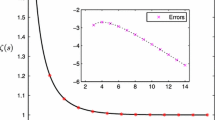Abstract
The infinite integral \(\int_0^{\infty}x\,dx/(1+x^6\sin^2x)\) converges but is hard to evaluate because the integrand f(x) = x/(1 + x 6sin2 x) is a non-convergent and unbounded function, indeed f(kπ) = kπ→ ∞ (k→ ∞). We present an efficient method to evaluate the above integral in high accuracy and actually obtain an approximate value in up to 73 significant digits on an octuple precision system in C++.
Similar content being viewed by others
References
Abramowitz, M., Stegun, I.A.: Handbook of Mathematical Functions. Dover, New York (1972)
Bornemann, F., Laurie, D., Wagon, S., Waldvogel, J.: The SIAM 100-digit Challenge: A Study in High-accuracy Numerical Computing. SIAM, Philadelphia (2004)
Brezinski, C., Zaglia, M.R.: Extrapolation Methods, Theory and Practice. Elsevier, Amsterdam (1991)
Espelid, T.O.: Computation of an infinite integral using series acceleration. Numer. Algorithms 40, 17–22 (2005)
Evans, G.: Practical Numerical Integration. Wiley, New York (1993)
Ford, W.F., Sidi, A.: An algorithm for a generalization of the Richardson extrapolation process. SIAM J. Numer. Anal. 24, 1212–1232 (1987)
Gautschi, W.: Numerical Analysis, An Introduction. Birkhäuser, Boston (1997)
Gautschi, W.: The numerical evaluation of a challenging integral. Numer. Algorithms 49, 187–194 (2008)
Goursat, É.: Cours d’Analyse Mathématique, tome 1. Gauthier Villars, Paris (1902)
Goursat, É.: A Course in Mathematical Analysis translated by Dunkel, O., Hedrick E.R. Ginn, Boston (1904)
Hardy, G.H.: Mathematical Messenger, XXXI (1902)
Hatano, Y., Ninomiya, I., Sugiura, H., Hasegawa, T.: Analysis of high-precision evaluation of Goursat’s infinite integral. Technical Report of the Nanzan Academic Society, NANZAN-TR-2008-01 (2008). http://www.seto.nanzan-u.ac.jp/msie/nas/tech-report/index.html
Henrici, P.: Applied and Complex Analysis, vol. 1. Wiley, New York (1974)
Ninomiya, I.: Improvement of adaptive Newton-Cotes quadrature methods. J. Inf. Process. 3, 162–170 (1980)
Ninomiya, I.: On a numerical integration by using an acceleration method. Kokyuroku, RIMS, Kyoto Univ. 585, 223–238 (1986) (in Japanese)
Sidi, A.: Practical Extrapolation Methods, Theory and Applications. Cambridge University Press, Cambridge (2003)
Slevinsky, M., Safouhi, H.: Numerical treatment of a twisted tail using extrapolation methods. Numer. Algorithms 48, 301–316 (2008)
Takahasi, H., Mori, M.: Double exponential formulas for numerical integration. Publ. RIMS, Kyoto Univ. 9, 721–741 (1974)
Author information
Authors and Affiliations
Corresponding author
Additional information
Dedicated to the memory of Professor Hideo Toda.
Technical details omitted in this paper are given in [12].
Rights and permissions
About this article
Cite this article
Hatano, Y., Ninomiya, I., Sugiura, H. et al. Numerical evaluation of Goursat’s infinite integral. Numer Algor 52, 213–224 (2009). https://doi.org/10.1007/s11075-009-9265-4
Received:
Accepted:
Published:
Issue Date:
DOI: https://doi.org/10.1007/s11075-009-9265-4
Keywords
- Infinite integral
- Unbounded integrand
- Contour integral
- Residues
- Numerical evaluation
- High accuracy
- Octuple precision




